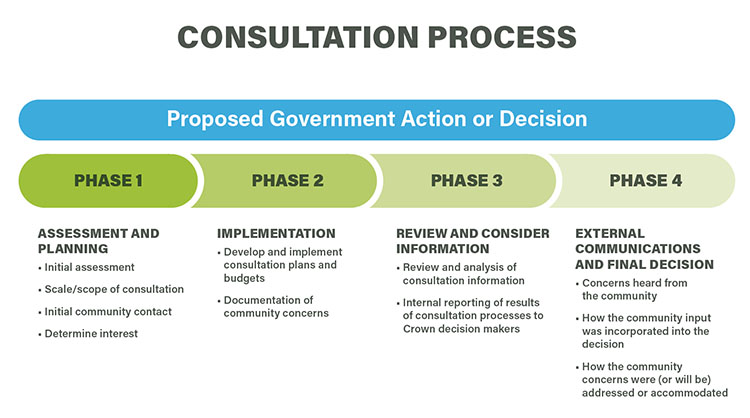Crown-Indigenous Consultation and Proponent Engagement
The Manitoba government is responsible for both Crown-Indigenous consultation and the proponent engagement process required for federal and provincial environmental authorizations:
- As a proponent, the federal government requires Manitoba Infrastructure to engage with potentially affected Indigenous groups to assist in fulfilling the federal Crown constitutional obligations and to fulfil the regulatory requirements for developing a complete Environmental Impact Statement.
- As the Crown, the Manitoba government also has a responsibility under Section 35 of Canada’s constitution to consult with Indigenous groups or communities whose exercise of treaty or Aboriginal rights might be affected by a government decision or action related to the project.
The Manitoba government recognizes that Indigenous groups and communities have the right to be informed about the impacts that a project may have on their rights and interests. They also have the right to express their views about the project and its impacts and have those views be given serious consideration and mitigated where appropriate.
Proponent Engagement
The proponent engagement process gathers information in support of federal regulatory decisions about impacts to Aboriginal and treaty rights.
The federal government assesses the proponent engagement activities by reviewing the information submitted, such as the Environmental Impact Statement, and other supplementary information provided throughout the environmental assessment process.
Crown-Indigenous Consultation
Before construction on the Lake Manitoba and Lake St. Martin outlet channels can begin, both the Manitoba government and the federal government have a legal duty to consult Indigenous groups potentially affected by the project.
The intent of Crown-Indigenous consultation is to provide meaningful opportunities for potentially affected Indigenous groups and communities to receive information about the proposed project, as well as provide these groups the opportunity to share information, concerns, and comments about the project.
Crown-Indigenous Consultation Process
The provincial Crown-Indigenous consultation process for the project was developed with guidance and direction from a Steering Committee with representation from the Manitoba departments of Agriculture and Resource Development (formerly Sustainable Development), Justice, and Indigenous and Northern Relations and Infrastructure.
There are four phases in the provincial Crown-Indigenous consultation process:
The Manitoba government undertakes an initial assessment of our duty for Crown-Indigenous consultation, which accounts for the community or groups:
- Proximity to the project footprint
- Potential environmental impacts
- Our current understanding of traditional land use.
The Manitoba government’s initial assessment is reviewed on an ongoing basis when additional information is received.
Manitoba Infrastructure is currently in Phase 2 of the process. This is the implementation phase where information is provided about the proposed project and its potential effects. Continued discussions with Indigenous groups and communities through this phase will help Manitoba Infrastructure to develop a further understanding of the interests and concerns of those potentially affected by the proposed project.
Public input
Water management is a highly technical and complex field and the consequences of various activities can be significant.
In this project, and all water management activities, the Manitoba government hopes to improve the public’s knowledge of how water control structures are operated, while providing a means for public review and discussion.
In 2012, the Assiniboine River and Lake Manitoba Basins Flood Mitigation Study was commissioned by the Manitoba government to assess a number of flood mitigation projects, including the Lake Manitoba and Lake St. Martin outlet channels project. A number of open house events for this study were held to provided an opportunity for stakeholders to examine proposals, express their opinions, and influence the conceptual design options of potential projects. The open house storyboards are available online at https://www.gov.mb.ca/mti/wms/wm/study.html. Open house events were also held between 2017 and 2019. Details and information from these events are outlined further in the next section.
Members of the public will continue to have additional opportunities to provide feedback through the provincial and federal environmental authorization processes. Questions and comments about the project can be directed to outletchannels@gov.mb.ca
Open House Events
Between 2017 and 2019, Manitoba held four rounds of open house events to solicit public feedback about this specific project.
- June and July 2017: Open houses were held in Moosehorn and Winnipeg to present the preferred channel alignments, changes to the road network, and potential environmental impacts.
- March 2018: Open houses were held in Moosehorn and Winnipeg to primarily discuss the proposed locations of the outlet channels and information regarding the environmental assessment process.
- June 2018: Open houses were held in Moosehorn, St. Laurent, Portage la Prairie, and Winnipeg to discuss the proposed locations of the outlet channels, the environmental assessment process, conceptual designs of the control structures, and preliminary proposed mitigation measures being considered for the project.
- June 2019: Open houses were held in Moosehorn and Winnipeg to discuss the proposed outlet channel project descriptions being submitted for the environmental authorization process, the steps involved in the environmental assessment, and the timeline.
The open house storyboards are available:
- Open House June 2017 (PDF, 11 MB)
- Open House June 2017 Environmental Information (PDF, 15 MB)
- Open House March 2018 (ZIP, 6.3 MB)
- Open House June 2018 (PDF, 35 MB)
- Open House June 2019 (PDF, 0.7 MB)
- Portage Diversion (PDF, 15 MB)



